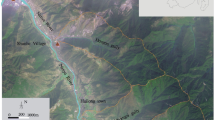Abstract
After the Wenchuan Earthquake, debris flows frequently occurred and became the disastrous geo-hazard following this Earthquake at the seriously hit areas. This paper focused on characteristics,hazards, change and mitigation of the debris flows along Min River. The investigation and test data showed that debris flows were characterized by various types, low triggering rainfall with over 30 mm/24 h and over 10 mm/h, the density of 2.01–2.21 t/m3, high frequency and large magnitude. Debris flow mainly appeared in the watersheds of which area and geomorphologic index (θ) was less than 10 km2 and 6, respectively, accounting for 89 %, and the hazardous watersheds were featured with the area of 2–8 km2 and the θ of 2–4. Moreover, debris flows occurred in simultaneity when rainfall reached 20 mm/h and produced step-dammed lakes. Debris flows and the following dammed lakes resulted in rapid change of river channel, endangered towns and frequently interrupted traffic. Debris flows, especially those from the watersheds with over 10 km2,will continuously endanger reconstruction projects and local people in the future 10–15 years before they recover normal. After analyzing the loose materials amount and the potential destructed objects, the 23 hazardous watersheds are suggested to control and prevent. Finally, the mitigation measures, including risk identification and zoning, hazards prediction, remote-monitoring and early-warning, emergency mitigation plan, integrated control and river channel dredging, are presented for debris flow hazards mitigation.
Access this chapter
Tax calculation will be finalised at checkout
Purchases are for personal use only
Similar content being viewed by others
References
Chen JC (2011) Variability of impact of earthquake on debris-flow triggering conditions: case study of Chen-Yu-Lan watershed, Taiwan [J]. Environ Earth Sci 64:1787–1794
Cui P, He SM, Yao LK et al (2011) Formation mechanism and risk control of mountain hazards induced by the Wenchuan earthquake [M]. Science Press, Beijing
Cui P, Wei FC, He SM et al (2008) Mountain disasters induced by the Earthquake of May 12 in Wenchuan and the disasters Mitigation [J]. J Mountain Sci 26(3):280–282
Ge YG, Zhuang JQ (2009) River channel change of the Upper of Minjiang River by 5. 12 Wenchuan Earthquake: a case study of the section of Dujiangyan-Wenchuan [J]. Geol Sci Technol Inform 28(2):23–28
Shieh CL, Chen YS, Tsai YJ et al (2009) Variability in rainfall threshold for debris flow after the Chi–Chi earthquake in central Taiwan, China [J]. Int J Sedim Res 24:177–188
Su FH, Cui P, Han YS et al (2009) Distribution analysis of mountain hazards induced by 5. 12 Wenchuan Earthquake along Dujiangyan-Wenchuan highway using Remote Sensing [J]. Geol Sci Technol Inf 28(2):29–32
Tang BX, Zhou BF, Wu JS et al (2000) Debris flows in China [M]. Commercial Press, Beijing, pp 1–14
Tang C, Zhu J, Ding J et al (2011) Catastrophic debris flows triggered by a 14 August, 2010 rainfall at the epicenter of the Wenchuan Earthquake [J]. Landslides 8:485–497
Tan WP (1996) Basic theory and study situation of rainstorm debris flow forecast in China [J]. J Soil Eros Soil Conserv 2(1):88–95
Xu Q, Zhang S, Li WL et al (2012) The 13 August 2010 catastrophic debris flows after the 2008 Wenchuan earthquake. China Nat Hazards Earth Syst Sci 12:201–216
Zhuang JQ, Cui P, Ge YG et al (2010) Probability assessment of river blocking by debris flow associated with the Wenchuan Earthquake. Int J Remote Sens 31(13):3465–3478
Acknowledgments
This work was jointly supported by National Basic Research Program of China (2011CB409902) and the program of Key Laboratory of Mountain Hazards and Surface Process, Chinese Academy of Sciences. The authors are very grateful for the helps of the other colleagues from Institute of Mountain Hazards and Environment, CAS.
Author information
Authors and Affiliations
Corresponding author
Editor information
Editors and Affiliations
Rights and permissions
Copyright information
© 2013 Springer-Verlag Berlin Heidelberg
About this paper
Cite this paper
Ge, Y., Cui, P., Chen, X., Zhu, X., Xiang, L. (2013). Characteristics, Hazards and Mitigation of Debris Flows Along Min River after the Wenchuan Earthquake. In: Ugai, K., Yagi, H., Wakai, A. (eds) Earthquake-Induced Landslides. Springer, Berlin, Heidelberg. https://doi.org/10.1007/978-3-642-32238-9_106
Download citation
DOI: https://doi.org/10.1007/978-3-642-32238-9_106
Published:
Publisher Name: Springer, Berlin, Heidelberg
Print ISBN: 978-3-642-32237-2
Online ISBN: 978-3-642-32238-9
eBook Packages: Earth and Environmental ScienceEarth and Environmental Science (R0)




